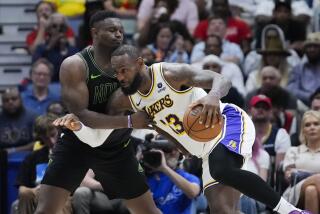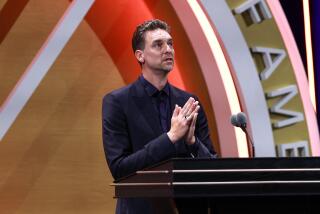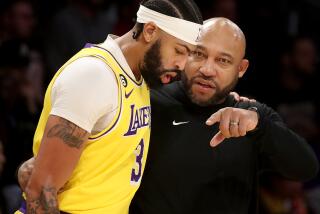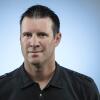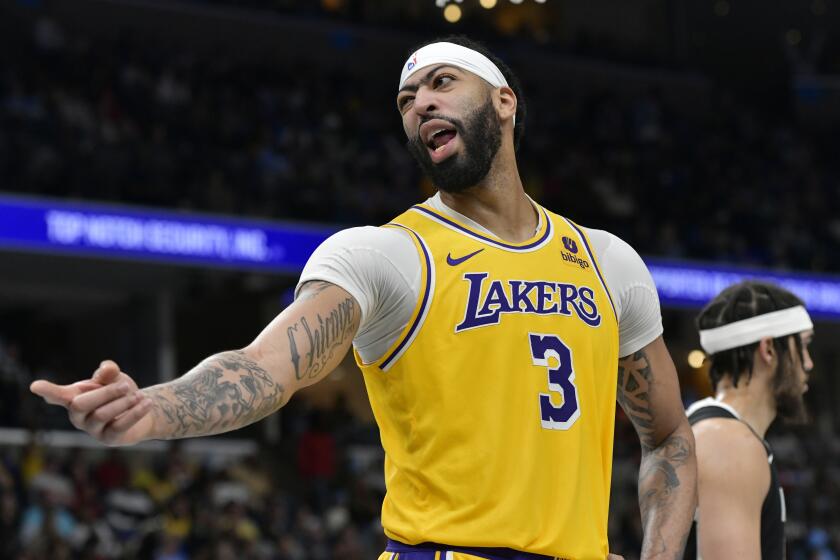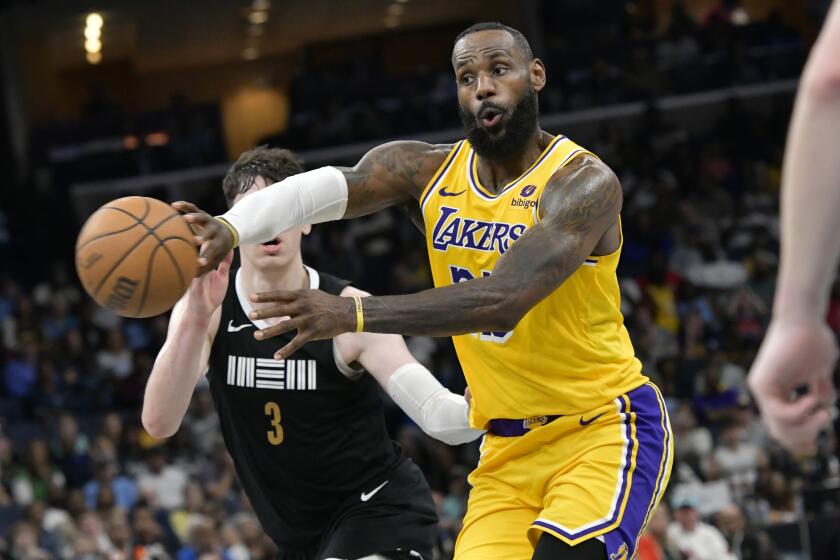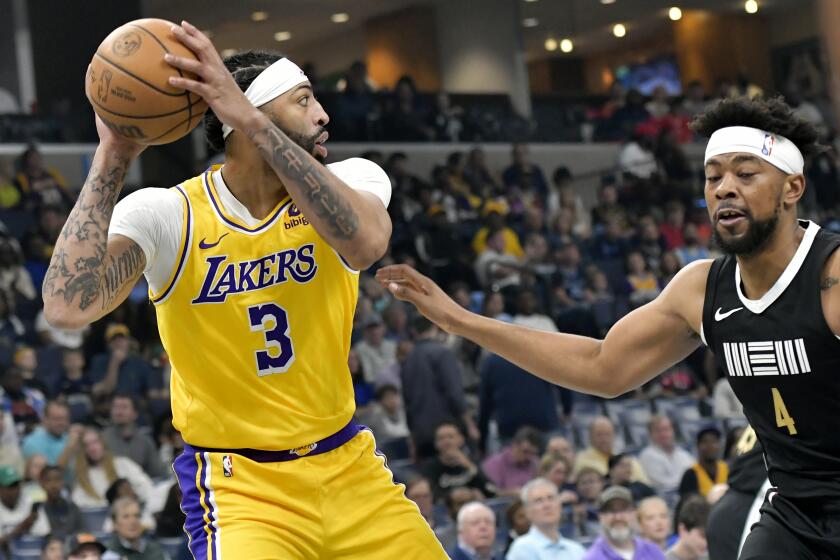Nerve Center
The best of times were a memory and the worst of times had just begun in the spring of 2005 when the Lakers drafted 17-year-old Andrew Bynum out of high school in what seemed the maraschino cherry on the sundae of their dysfunction.
Dysfunction was a popular word around them after eight years of Shaquille O’Neal and Kobe Bryant, but those now seemed like the good old days.
O’Neal was gone. Jerry West was gone. Chick Hearn was gone.
Rudy Tomjanovich, hired to replace Phil Jackson, had come and gone, fleeing within months to be replaced by . . . Jackson, who had been gone but was back.
Owner Jerry Buss, who had let Jackson go and was obliged to rehire him, seemed out of touch, musing that his 34-48 team could be in the Western Conference finals in “a couple of years.”
In fact, Buss was more detached than ever, involving his son Jim in decisions, which, as far as Lakers fans were concerned, was like Jed Clampett turning the Beverly Hillbillies over to nephew Jethro.
The real heat was on General Manager Mitch Kupchak, whose challenge -- build a dynasty from the ashes of the old one -- was the NBA equivalent of “Mission: Impossible.”
Bryant and Lamar Odom fit awkwardly. The West was even wilder with Steve Nash taking Phoenix from 29-53 to 62-20, forming a new elite class with San Antonio and Dallas the Lakers couldn’t hope to crack.
Kupchak was second-guessed within the organization, scorched up and down the radio dial and asked to resign by a season-ticket holder at a town hall meeting.
At this low ebb, the Lakers -- with Kupchak in the lead, Jim Buss playing an important role and Jerry Buss going for broke as he always had -- made one of the most functional decisions in their history, gambling on the 7-foot Bynum with the No. 10 pick.
If one move won Bryant back after his days of rage in the spring of 2007, it wasn’t the subsequent trade for Pau Gasol but the selection of Bynum two years before.
By the time Gasol arrived, three weeks after Bynum was lost because of a knee injury, Bynum’s quantum leap had already turned Bryant around.
Bryant, who had railed at management for not trading the young center, demanded to be traded himself and then maintained a stony detachment, was all the way back to hope, noting after Bynum’s injury, “We’re a championship-caliber team with him in the lineup.”
This, then, is how the Lakers literally saved the day.
Finding Andrew
The first time the Lakers saw Bynum, then a plump 300-pounder, was that spring in the McDonald’s All-American game in South Bend, Ind., and they couldn’t imagine taking him.
Jerry Buss, who paid Tomjanovich $6 million, as much as he paid Jackson, had no intention to rebuild. Lakers people didn’t even say rebuilding. Rudy T called it “the R word.”
However, a month after the McDonald’s game, personnel director Ronnie Lester saw a trimmer 275-pound Bynum at a workout in New York and told Kupchak they had better check him out.
Bynum then worked out in secret for Kupchak, Lester, scout Bill Bertka and Jim Buss at the pre-draft camp in Chicago and once more in Los Angeles for Jackson.
Jackson was impressed but, with only a three-year contract, preferred someone such as Arizona’s Channing Frye, who could play for him immediately.
Meanwhile, with the word spreading, Bynum went to work out for the Portland Trail Blazers, who had the No. 3 pick, then to see the Golden State Warriors, who had No. 8.
“They [the Lakers] were like, ‘We’re really interested. We can’t guarantee, but you’re really high on our list,’ ” Bynum says. “We were like, ‘OK, well, we’ll go work out for Portland.’ So then when I went to work out for Portland, I did really, really well there. . . .
“I was about to work out for Golden State. I actually went up and talked to [GM] Chris Mullin.”
Which is when the Lakers jumped all the way in, committing themselves to draft him and ending the process. “I was just about to start the workout when [the Lakers] called,” Bynum says, adding that he “shut it down” right then and there.
Intrigued as the Lakers were, getting a commitment from Jerry Buss for “a high school kid that nobody knows,” as Kupchak put it, was no slam dunk.
That was where Jim Buss came in. As enthusiastic as the rest of the staff, Jim called his father, who was in Europe, and convinced him it was a gamble worth taking, the kind West had built the franchise on.
Now Bynum just had to last until No. 10.
Drafting Andrew
Fortunately for the Lakers, Portland traded down, sending its pick to Utah, which wanted Deron Williams. The Warriors still wanted a post player but took a smaller one whom they had at least seen, Arizona State’s Ike Diogu.
The New York Knicks took Frye at No. 9. And with the next pick, the Lakers got Bynum, four months shy of his 18th birthday, the youngest player in NBA history and already the center of a controversy.
“I thought he was a huge reach,” says AM 570 “Loose Cannons” co-host Steve Hartman. “You’re talking about a 10th-place team that needed immediate help.
“I was a Sean May fan. Maybe I was high on him from the [NCAA] tournament, but at least he could play now.”
That was what it had come down to for the Lakers: Bynum or May, the North Carolina center who had led the Tar Heels to the NCAA title but turned out to be 6-7 in stocking feet.
The consensus everywhere else was clear: May.
Memphis GM Chris Wallace, then in Boston, remembers the surprise at the University of Connecticut, where Bynum had been expected to back up veterans Josh Boone and Hilton Armstrong.
“There were some disconcerted people back in our area,” Wallace says. “People were saying he’s not even going to start at UConn, he’s going to be third team.”
Bynum’s coach at St. Joseph’s High in Metuchen, N.J., Mark Taylor, was flabbergasted.
“I question his mentality,” said Taylor, noting their early exit in the state tournament. “If he’s an NBA player now, how do I lose in the first round?”
However, the Lakers hadn’t been the only ones to notice Bynum. The Knicks’ Isiah Thomas called the next day to ask if Bynum would be available in a trade.
Says Donnie Walsh, another Bynum admirer who was then the Indiana Pacers’ president and has since succeeded Thomas with the Knicks:
“I thought, ‘Wow, I didn’t expect that, and I particularly didn’t expect the Lakers to do that.’
“And then I thought, ‘That’s when to do it. This guy, if he develops, he could be a center that would take you 20 years to get.’ ”
Of course, it would be years before anyone knew what kind of center Bynum would be. For the Lakers organization, it would be the longest years they had ever known.
Tomorrow, in Part 2: Kobe and Andrew, a love story, at least in the end.
--
mark.heisler@latimes.com
--
(BEGIN TEXT OF INFOBOX)
2005 NBA DRAFT
*--* 1. Milwaukee Bucks Andrew Bogut 2. Atlanta Hawks Marvin Williams 3. Utah Jazz Deron Williams 4. New Orleans Hornets Chris Paul 5. Charlotte Bobcats Raymond Felton 6. Portland Trail Blazers Martell Webster 7. Toronto Raptors Charlie Villanueva 8. New York Knicks Channing Frye 9. Golden State Warriors Ike Diogu 10. Los Angeles Lakers Andrew Bynum *--*
More to Read
All things Lakers, all the time.
Get all the Lakers news you need in Dan Woike's weekly newsletter.
You may occasionally receive promotional content from the Los Angeles Times.
